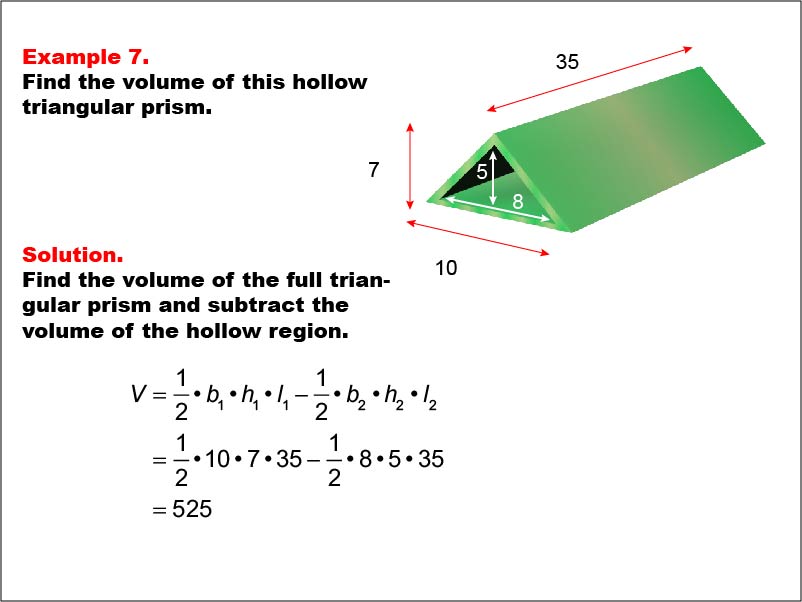
Display Title
Math Example--Volume Concepts--Calculating Volume: Example 7
Display Title
Math Example--Volume Concepts--Calculating Volume: Example 7

Topic
Volume
Description
The image shows a hollow triangular prism with outer dimensions labeled as base (10), height (7), and length (35), and inner dimensions labeled as base (8) and height (5). The example calculates the volume by subtracting the hollow region from the full prism. This image illustrates Example 7: "Find the volume of this hollow triangular prism." The solution calculates the full volume using V = 1/2 * b1 * h1 * l1 - 1/2 * b2 * h2 * l2, which simplifies to V = 1/2 * 10 * 7 * 35 - 1/2 * 8 * 5 * 35 = 525..
Volume is a fundamental concept in geometry that helps students understand the space occupied by three-dimensional objects. In this collection, each example uses various geometric shapes to calculate volume, showcasing real-life applications of volume in different shapes.
Seeing multiple worked-out examples allows students to observe different approaches and nuances in calculations, which reinforces their understanding of volume across shapes.
Teacher's Script: Observe this example carefully. Notice the steps taken to find the volume of this particular shape. Can you see how each dimension--length, width, and height--plays a role in determining the overall volume? How might you apply this to other shapes?
For a complete collection of math examples related to Volume click on this link: Math Examples: Volume Collection.
| Common Core Standards | CCSS.MATH.CONTENT.6.G.A.2, CCSS.MATH.CONTENT.7.G.B.6, CCSS.MATH.CONTENT.8.G.C.9, CCSS.MATH.CONTENT.5.MD.C.4, CCSS.MATH.CONTENT.5.MD.C.5.A, CCSS.MATH.CONTENT.5.MD.C.5.B, CCSS.MATH.CONTENT.5.MD.C.5.C |
|---|---|
| Grade Range | 5 - 8 |
| Curriculum Nodes |
Geometry • Surface Area and Volume • Volume |
| Copyright Year | 2013 |
| Keywords | volume |